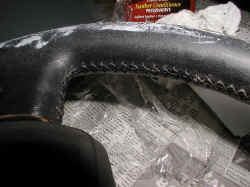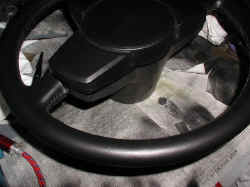I've put a thin coat of FlexFill on the
portion of the wheel that suffered from surface cracking, then I've sanded
it back down. I probably need to do a bit more sanding, then perhaps some
more FlexFill touchups, then fix the broken stitches and after that it
will be ready for redying. |

|

|
To the left are a couple of the stitch repairs, I think there was at least one
other spoke that needed it. The easy way to tell (in addition to the fact I
overlapped at the first set of holes, i.e. there is one set of stitches where
both the old thread ends and the new begins), is that the new thread is black
and the old thread's dye has bleached out somewhat (also taken care of by the
redye)...
|

|
|
|
I later added more FlexFills in areas that needed it,
and sanded it back down, then sponged it and wiped with a rag to clean off
the debris. Unfortunately, I didn't take any pics of it just prior to
spraying, which would have shown that there was actually a good bit less
FlexFill remaining than even in the picture above. I did not want to end
up with a repair that looked like those deals where somebody tries to
patch holes in their car with Bondo!
|

|
|

|
Here are the final results. I'd still like to hold onto it
for a day or two to let it 'cure', and also I may want to buff out the
center pad a bit during that time and put another coat on it. I'm not as
happy with the pad yet as I am with the rest of the wheel - which I'm VERY
happy with! The patient has survived!
|
|

|

|
|
|
|
|
|
|
|
|
![]() Downshift to first: return to
Recovery Customer Status page
Downshift to first: return to
Recovery Customer Status page ![]() Reverse to Porsche Obsession homepage
Reverse to Porsche Obsession homepage accesses since odometer installed (27-Oct-2000)